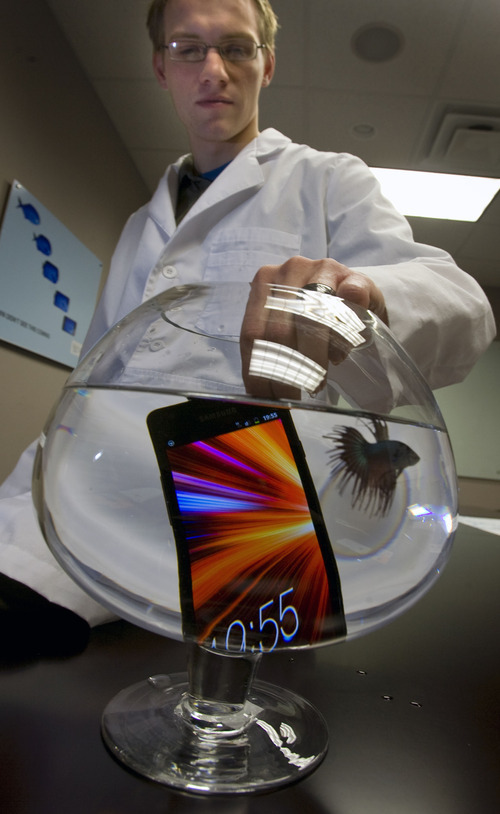This is an archived article that was published on sltrib.com in 2012, and information in the article may be outdated. It is provided only for personal research purposes and may not be reprinted.
It's possibly the greatest fear of anyone who owns an expensive electronic smartphone: dropping it in the toilet.
But it happens. A Salt Lake County company believes it has devised a scientific method that can take the pain out of the major faux pas of getting water on your $200 iPhone.
At the International Consumer Electronics Show in Las Vegas last week, HzO wowed media and trade show attendees with its new technology called WaterBlock, a chemical process that seals the electronics inside a device as opposed to just putting the gadget in a water-tight case or bag. The process was honored with this year's CES Innovations Design and Engineering Award.
"It's going to save us!" announced "Good Morning America" tech correspondent Becky Worley when she showed off the technology to her TV audience.
"The most astonishing products here at the International Consumer Electronics Show are often the ones you can't buy yet, like a process called WaterBlock from the company HzO," wrote Roy Furchgott on The New York Times' Gadgetwise blog.
WaterBlock is a proprietary chemical formulation that is turned into a gas in a chamber before it's introduced into an electronic device such as a smartphone or MP3 player.
"That gas forms to whatever we want, into every little small nook and cranny of that circuit board," said the company's chief executive and president Paul Clayson. "We don't have to take it apart. It can go in through the earphone jack or charging jack, any of the holes in the device."
The chemical seals itself around all of the electronic components and prevents the electrical current from shorting out the device when it comes in contact with water.
On the CES floor, Clayson showed attendees how WaterBlock works by completely submerging a smartphone coated with the chemical into a water tank; the gadget still worked.
"It's so robust and works so well, I can take the phone, take the back off and drop the phone in the water, and they can see it swimming in the water, and [the phone] still works," Clayson said. "It's so counter-intuitive to what people think a phone can do in the water."
Don't think you can just go to an HzO kiosk and have this installed on your phone anytime soon. The installation of WaterBlock to a gadget wouldn't be sold directly to a consumer. Rather, it's a process that would be introduced into the manufacturing line, and the final product would be sold with the chemical sealant already installed.
"We've innovated equipment processes in addition to our formulation that is all part of our intellectual property. One of the key parts is we have developed a machine that can sit in the middle of an assembly line at a consumer electronics manufacturer where they can put these devices out at a high rate in a day," Clayson said.
Clayson said he has worked out deals with some manufacturers, though he will not say who yet. He expects the first products to come out with the WaterBlock sealant this summer.
The idea for WaterBlock arose in 2007 after an accident in which a student with the Northeast Maritime Institute died after falling into a river and couldn't call for help from his water-damaged cellphone or two-way radio, Clayson said.
The school hired an engineer to come up with a process to protect electronic equipment from water damage. In 2009, the Salt Lake County-based company ZAGG Inc., which makes protective film and accessories for electronic devices, bought a controlling interest in the company developing the technology. Since then, HzO was spun off from ZAGG and will be taking the technology to market.
Clayson says the chemical formulation can be applied to a lot of different devices and materials. He hopes to see it used with marine equipment, solar-powered devices and equipment used by emergency services like police and paramedics.
"It also works very well with fabrics. It works very well on footwear. It's very broad ranging," he said. "We chose to go to market with personal electronics because the timing is perfect with the prices of devices being driven up."
vince@sltrib.comTwitter: @ohmytechGoogle+: +Vincent Horiuchi







